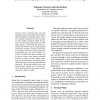Free Online Productivity Tools
i2Speak
i2Symbol
i2OCR
iTex2Img
iWeb2Print
iWeb2Shot
i2Type
iPdf2Split
iPdf2Merge
i2Bopomofo
i2Arabic
i2Style
i2Image
i2PDF
iLatex2Rtf
Sci2ools
EMNLP
2008
2008
Jointly Combining Implicit Constraints Improves Temporal Ordering
Previous work on ordering events in text has typically focused on local pairwise decisions, ignoring globally inconsistent labels. However, temporal ordering is the type of domain in which global constraints should be relatively easy to represent and reason over. This paper presents a framework that informs local decisions with two types of implicit global constraints: transitivity (A before B and B before C implies A before C) and time expression normalization (e.g. last month is before yesterday). We show how these constraints can be used to create a more densely-connected network of events, and how global consistency can be enforced by incorporating these constraints into an integer linear programming framework. We present results on two event ordering tasks, showing a 3.6% absolute increase in the accuracy of before/after classification over a pairwise model.
EMNLP 2008 | Global Constraints | Implicit Global Constraints | Local Pairwise Decisions | Natural Language Processing |
| Added | 29 Oct 2010 |
| Updated | 29 Oct 2010 |
| Type | Conference |
| Year | 2008 |
| Where | EMNLP |
| Authors | Nathanael Chambers, Daniel Jurafsky |
Comments (0)

